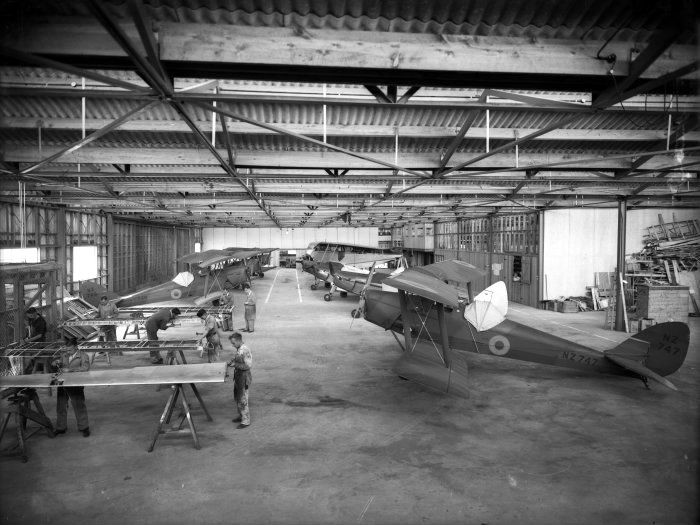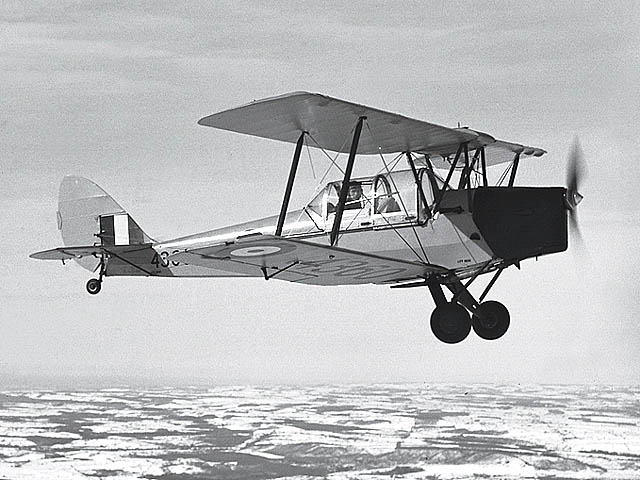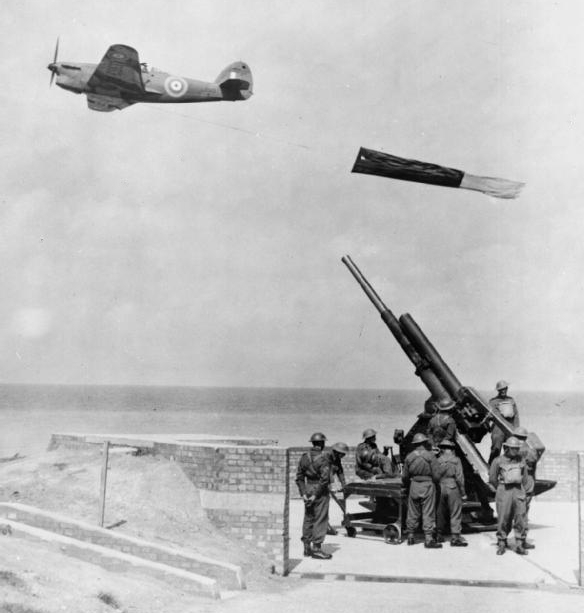|
RAF Cleave
RAF Cleave is a former Royal Air Force station located north of Bude in Cornwall, United Kingdom, which was operational from 1939 until 1945. Despite a few periods of intense activity, it was one of Fighter Command's lesser used airfields. History RAF Cleave was conceived as housing target and target support aircraft for firing ranges along the north Cornwall coast, and land was acquired from Cleave Manor. In May 1939, two flights of No. 1 Anti-Aircraft Co-operation Unit RAF (1 AACU) with the Westland Wallace, and a naval steam catapult was soon erected near the cliffs for the pilotless Queen Bee aircraft due to be stationed there. Aircraft were initially housed in temporary Bessonneau hangars (type H of World War I vintage), and later replaced by more permanent structures. In December 1943, the four flights were amalgamated into 639 Squadron, which served at Cleave for the remainder of the war. The airfield was placed under care and maintenance in April 1945, and later ... [...More Info...] [...Related Items...] OR: [Wikipedia] [Google] [Baidu] |
Kilkhampton
Kilkhampton ( kw, Kylgh) is a village and civil parishes in England, civil parish in northeast Cornwall, England, United Kingdom. The village is on the A39 road#Atlantic Highway, A39 about four miles (6 km) north-northeast of Bude. Kilkhampton was mentioned in the Domesday Book as "Chilchetone". The population of the parish was 1,193 in the 2001 census. This increased to 1,368 in the 2011 census The remains of a late Norman period motte-and-bailey castle known as Penstowe Castle are located 500 metres west of the village. Further west, at Stowe is the site of Stowe House, Kilkhampton, Stowe House, the grand mansion of John Granville, 1st Earl of Bath, built in 1680 but demolished in 1739: some of the stonework was reused at Penstowe, also in the parish. Kilkhampton has a post office, a primary school, and a community centre called the Grenville Rooms. There are three general stores, two pubs, and a selection of shops including an electrical goods store. There is also a ... [...More Info...] [...Related Items...] OR: [Wikipedia] [Google] [Baidu] |
1943 In The United Kingdom
Events from the year 1943 in the United Kingdom. The year was dominated by the Second World War. Incumbents * Monarch – George VI * Prime Minister – Winston Churchill (Coalition) * Parliament – 37th Events * 1 January ** Total ban on civilians travelling to the Isle of Wight (continues until 25 August 1944). ** Utility furniture first becomes available. * 14 January – to counter a "serious increase" in U-boat operations the Royal Air Force switches its bombing campaign from industrial targets to U-boat bases in France attacking Lorient and Cherbourg-Octeville. * 17 January – anti-aircraft shrapnel shells kill 23 people and injure 60 during a raid on London by 118 planes; six are reported losses. * 20 January – Sandhurst Road School Disaster: a bomb kills 38 children and 6 teachers at a school in Catford, south-east London. * 23 January – World War II: British forces capture Tripoli from the Nazis. * 11 February – in the Midlothian and Peebles Northern by-elec ... [...More Info...] [...Related Items...] OR: [Wikipedia] [Google] [Baidu] |
Married Quarter
Marriage, also called matrimony or wedlock, is a culturally and often legally recognized union between people called spouses. It establishes rights and obligations between them, as well as between them and their children, and between them and their in-laws. It is considered a cultural universal, but the definition of marriage varies between cultures and religions, and over time. Typically, it is an institution in which interpersonal relationships, usually sexual, are acknowledged or sanctioned. In some cultures, marriage is recommended or considered to be compulsory before pursuing any sexual activity. A marriage ceremony is called a wedding. Individuals may marry for several reasons, including legal, social, libidinal, emotional, financial, spiritual, and religious purposes. Whom they marry may be influenced by gender, socially determined rules of incest, prescriptive marriage rules, parental choice, and individual desire. In some areas of the world, arranged ... [...More Info...] [...Related Items...] OR: [Wikipedia] [Google] [Baidu] |
Perimeter Track
A perimeter is a closed path that encompasses, surrounds, or outlines either a two dimensional shape or a one-dimensional length. The perimeter of a circle or an ellipse is called its circumference. Calculating the perimeter has several practical applications. A calculated perimeter is the length of fence required to surround a yard or garden. The perimeter of a wheel/circle (its circumference) describes how far it will roll in one revolution. Similarly, the amount of string wound around a spool is related to the spool's perimeter; if the length of the string was exact, it would equal the perimeter. Formulas The perimeter is the distance around a shape. Perimeters for more general shapes can be calculated, as any path, with \int_0^L \mathrms, where L is the length of the path and ds is an infinitesimal line element. Both of these must be replaced by algebraic forms in order to be practically calculated. If the perimeter is given as a closed piecewise smooth plane curve ... [...More Info...] [...Related Items...] OR: [Wikipedia] [Google] [Baidu] |
Runway
According to the International Civil Aviation Organization (ICAO), a runway is a "defined rectangular area on a land aerodrome prepared for the landing and takeoff of aircraft". Runways may be a man-made surface (often asphalt concrete, asphalt, concrete, or a mixture of both) or a natural surface (sod, grass, soil, dirt, gravel, ice, sand or road salt, salt). Runways, as well as taxiways and Airport apron, ramps, are sometimes referred to as "tarmac", though very few runways are built using Tarmacadam, tarmac. Takeoff and landing areas defined on the surface of water for seaplanes are generally referred to as waterways. Runway lengths are now International Civil Aviation Organization#Use of the International System of Units, commonly given in meters worldwide, except in North America where feet are commonly used. History In 1916, in a World War I war effort context, the first concrete-paved runway was built in Clermont-Ferrand in France, allowing local company Michelin to ... [...More Info...] [...Related Items...] OR: [Wikipedia] [Google] [Baidu] |
Cleave Camp, Old Gun Emplacement And Dish, December 2013
{{disambiguation ...
Cleave may refer to: *Cleave (surname) *Cleave (fiber), a controlled break in optical fiber *RAF Cleave, was an airfield in the north of Cornwall, England, May 1939 - Nov 1945 *The process of protein cleaving as a form of post-translational modification * ''Cleave'' (Therapy? album), 2018 * "Cleaved" (''Star vs. the Forces of Evil''), a 2019 episode See also *Cleavage (other) *Cleaver (other) *Cleeve (other) *Cleaves (surname) *Cleft (other) *Van Cleave Van Cleave (born Nathan Lang Van Cleave, May 8, 1910 – July 3, 1970) was a composer and orchestrator for film, television, and radio. Biography Born in Bayfield, Wisconsin, he played with big bands, including Doc Fenton and his Sooners ... [...More Info...] [...Related Items...] OR: [Wikipedia] [Google] [Baidu] |
Hawker Hurricane
The Hawker Hurricane is a British single-seat fighter aircraft of the 1930s–40s which was designed and predominantly built by Hawker Aircraft Ltd. for service with the Royal Air Force (RAF). It was overshadowed in the public consciousness by the Supermarine Spitfire during the Battle of Britain in 1940, but the Hurricane inflicted 60 percent of the losses sustained by the Luftwaffe in the campaign, and fought in all the major theatres of the Second World War. The Hurricane originated from discussions between RAF officials and aircraft designer Sir Sydney Camm about a proposed monoplane derivative of the Hawker Fury biplane in the early 1930s. Despite an institutional preference for biplanes and lack of interest by the Air Ministry, Hawker refined their monoplane proposal, incorporating several innovations which became critical to wartime fighter aircraft, including retractable landing gear and the more powerful Rolls-Royce Merlin engine. The Air Ministry ordered Hawker's ''Int ... [...More Info...] [...Related Items...] OR: [Wikipedia] [Google] [Baidu] |
De Havilland Queen Bee
The de Havilland DH.82 Tiger Moth is a 1930s British biplane designed by Geoffrey de Havilland and built by the de Havilland Aircraft Company. It was operated by the Royal Air Force (RAF) and other operators as a primary trainer aircraft. In addition to the type's principal use for ''ab initio'' training, the Second World War had RAF Tiger Moths operating in other capacities, including maritime surveillance and defensive anti-invasion preparations; some aircraft were even outfitted to function as armed light bombers. The Tiger Moth remained in service with the RAF until it was replaced by the de Havilland Chipmunk during the early 1950s. Many of the military surplus aircraft subsequently entered into civilian operation. Many nations have used the Tiger Moth in both military and civilian applications, and it remains in widespread use as a recreational aircraft. It is still occasionally used as a primary training aircraft, particularly for those pilots wanting to gain experi ... [...More Info...] [...Related Items...] OR: [Wikipedia] [Google] [Baidu] |
De Havilland Tiger Moth
The de Havilland DH.82 Tiger Moth is a 1930s British biplane designed by Geoffrey de Havilland and built by the de Havilland Aircraft Company. It was operated by the Royal Air Force (RAF) and other operators as a primary trainer aircraft. In addition to the type's principal use for ''ab initio'' training, the Second World War had RAF Tiger Moths operating in other capacities, including maritime surveillance and defensive anti-invasion preparations; some aircraft were even outfitted to function as armed light bombers. The Tiger Moth remained in service with the RAF until it was replaced by the de Havilland Chipmunk during the early 1950s. Many of the military surplus aircraft subsequently entered into civilian operation. Many nations have used the Tiger Moth in both military and civilian applications, and it remains in widespread use as a recreational aircraft. It is still occasionally used as a primary training aircraft, particularly for those pilots wanting to gain exper ... [...More Info...] [...Related Items...] OR: [Wikipedia] [Google] [Baidu] |
Fairey Battle
The Fairey Battle is a British single-engine light bomber that was designed and manufactured by the Fairey Aviation Company. It was developed during the mid-1930s for the Royal Air Force (RAF) as a monoplane successor to the Hawker Hart and Hind biplanes. The Battle was powered by the same high-performance Rolls-Royce Merlin piston engine that powered various contemporary British fighters such as the Hawker Hurricane and Supermarine Spitfire. As the Battle, with its three-man crew and bomb load, was much heavier than the fighters, it was therefore much slower. Though a great improvement over the aircraft that preceded it, its relatively slow speed, limited range and inadequate defensive armament of only two .303 (7.7 mm) machine guns left it highly vulnerable to enemy fighters and anti-aircraft fire.Ethell 1995, p. 177. The Fairey Battle was used on operations early in the Second World War. During the "Phoney War" the type achieved the distinction of scoring the first aer ... [...More Info...] [...Related Items...] OR: [Wikipedia] [Google] [Baidu] |
Hawker Henley
The Hawker Henley was a British two-seat target tug derived from the Hawker Hurricane that was operated by the Royal Air Force during the Second World War. Design and development In 1934 Air Ministry Specification P.4/34 was issued which called for a light bomber that could also be deployed in a close-support role as a dive-bomber. Fairey, Gloster and Hawker attempted to fulfil this need and competition was tight to attain the highest performance possible. As the aircraft required only a modest bomb load and with performance being paramount, the Hawker design team chose to focus its efforts on developing an aircraft similar in size to their Hurricane fighter. The Hurricane was then in an advanced design stage and there would be economies of scale if some assemblies were common to both aircraft. This resulted in the Henley, as it was to become known, sharing identical outer wing panel and tailplane jigs with the Hurricane. Both were equipped with the Rolls-Royce Merlin engi ... [...More Info...] [...Related Items...] OR: [Wikipedia] [Google] [Baidu] |
1942 In The United Kingdom
Events from the year 1942 in the United Kingdom. The year was dominated by the Second World War. Incumbents * Monarch – George VI * Prime Minister – Winston Churchill (Coalition) * Parliament – 37th Events * 1 January ** Sneyd Colliery Disaster: An underground explosion in the North Staffordshire Coalfield kills 55. ** Book Production War Economy Agreement comes into force. * 9–29 January – 1942 Betteshanger miners' strike in the Kent Coalfield. * 10 January – World War II: Liverpool Blitz ends with German bombs dropped in the Stanhope Street area of the city, with nine people dying and many more suffering injuries. Among the houses destroyed in the bombing is the former home of Adolf Hitler's half-brother Alois. Four more people die as a result of their injuries the following day. * 26 January – World War II: First United States troops for the European theatre arrive in the UK, at Belfast. * 29 January – radio programme ''Desert Island Discs'' first broadcast ... [...More Info...] [...Related Items...] OR: [Wikipedia] [Google] [Baidu] |








